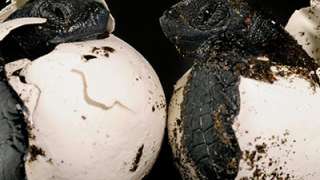MEDIA
Arrested Development
www.hakaimagazine.com | August 6, 2020
A low-tech solution offers an effective way to keep sea turtles safe.
Before a female sea turtle comes ashore to bury its eggs in the sand, it stores them in its oviduct in a state of hibernation. Known as arrested embryonic development, this evolved form of suspended animation is a biological hack that some egg-laying reptiles use to give their offspring the best shot at life. It means the mother can hold onto its eggs until the time is right to lay them.
As a mother turtle deposits its eggs in the nest, they are briefly subjected to the oxygen in the air before being covered in sand. This flash of oxygen triggers the embryos to start growing again.
Inspired by this natural adaptation, scientists have learned how to put the embryos back into hibernation—a potentially life-saving technique. The method, discovered by Sean Williamson, a conservation biologist from Monash University in Australia, and his colleagues is relatively simple: put the eggs in a vacuum-seal bag, like those used to store food, and suck out the air with a handpump. The technique can help protect sea turtle eggs during transport if they need to be relocated to save them from being destroyed by rising tides, storm surges, predators, or poachers.
Embryonic turtles are incredibly sensitive to movement as well as oxygen. During the first 12 hours of their development outside the mother’s oviduct, the membrane enveloping a sea turtle embryo attaches to the inside of the shell. If this membrane ruptures, perhaps because of a sudden movement, the turtle will die. “If you’re going to move the eggs, you need to do it in the very early stages of development,” says Williamson.
But as Williamson discovered, putting the eggs back into low-oxygen conditions within that early 12-hour window means you can artificially extend their developmental arrest. “It buys you more time to relocate those eggs to a safer location,” he says. For Olive ridley and Kemp’s ridley sea turtles, their embryos seem to tolerate this artificial hibernation better than other species, up to 15 days in some experiments. He and his colleagues have used the approach to safely transport eggs thousands of kilometers from around Australia to their lab in Melbourne.
Since the 1980s, researchers have used other techniques to slow turtles’ development to give them a better chance at survival during transportation. They usually involved chilling the eggs on ice to between 4 and 10 °C, or creating low oxygen conditions in a sealed container by replacing the air with nitrogen gas. However, these techniques present huge logistical challenges for people working in remote and tropical locations. Unfortunately, Williamson says, researchers accidentally killed many sea turtles when eggs froze or overheated during transport. That motivated him to devise a simpler, safer method.
Andrea Phillott, a marine biologist at FLAME University in India, who works with sea turtle conservation programs in Australia, Bangladesh, and India, says that the technique will be useful for researchers needing to transport turtle eggs long distances. But she says that conservation groups may be less likely to adopt the technique. Most hatcheries are located near nesting beaches and there are many ways conservationists can protect eggs in their original locations.
Phillott, who was not involved in the study, notes that the bags would be useful for translocations in extreme circumstances. In 2010, for example, over 25,000 sea turtle eggs were moved in hundreds of ice-filled coolers from the Gulf of Mexico to Florida’s Atlantic coast to save them from the Deepwater Horizon oil spill. More than half survived, but it would have been easier without all that ice.
As for how many conservationists and research teams might adopt the technique, time will tell: there have only been a few nesting seasons in the two and a half years since the method was published.
*Views expressed are personal.
(Source: https://www.hakaimagazine.com/news/arrested-development/)

